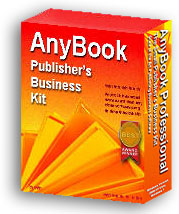Upgrading & Re-installing AnyBook. . .
If you are already an AnyBook user, here's how to re-install the program or to install an upgrade
(Note: Are you installing the program for the first time? If so, see first time installation instructions. The directions, below, are for current users of AnyBook.)
If you are re-installing the program or if you are installing an upgrade, follow the procedure below
1) Back-up Files. Make sure you have backed-up your files. This normally is done at the end of every session, but for an install, you should give yourself an added measure of security and back-up your files to a second directory or flash drive.
2) Additional Files to Back-up. Note that not all files are backed up. The easiest way to back-up these files is use the Local Back-up feature (FILE >> LOCAL BACK-UP & RESTORE). It handles everything for you, but, if desired, you can manually copy them to a separate back-up disk or to another directory on your hard drive before installing. If you use the manual method, here's what you want to copy:
a) Any graphics files (*.bmp) that you are using for logos on your invoices, billings or royalty reports. In other words, if you have a logo on your invoices, make sure that you have a copy the logo file stored away some place. If not, look for *. bmp files in C:\AnyBook and copy all of them to your back-up directory or flash drive.
b) Any Internet Macros (*.iim) that you have created or altered. If you haven't created any Internet Macros, you don't have to worry about this.
c) Any forms, documents, mail merge letters or label lay-outs that you've created in Microsoft Word and are stored in the C:\AnyBook\My_Files or C:\AnyBook\Labels directories. If you are unsure of this, copy each of these subdirectories to a back-up directory or flash drive.
If you have a network the following files include local settings. When copying these files be sure to use a different directory than your regular back-up directory. (It's easier to use the Local Back-up feature, mentioned above, to back-up these files, but we're including this information so that you are aware of which files contain local computer data.)
a) The file BSetUp.dbf include a number of local settings, including the path to the common data directory on the server.
b) Forms, documents, mail merge letters or label lay-outs may be saved on the local computer on the following local directories C:\AnyBook\My_Files or C:\AnyBook\Labels.
c) Additionally, Labeling.dbf includes quite a number of settings related to creating labels.
NOTE: The new version of AnyBook (Version 14 or greater) has a handy feature which will back-up the above files. If you are using AnyBook on a Network, this feature will also save your local network settings for each workstation. To access it, select File >> Local Back-up & Restore. Select the "Back-up" option to back-up files.
3) Clean Install. If you are doing a "clean" install, you'll want to uninstall the old program. A clean install is highly recommended when you move from lower level to a higher level. For example if you move from Level III to Level V, you'll want to do a clean install. (Note that a clean install is mandatory if you are upgrading to Version 14 from any version prior to version 14. Version 14 has a new runtime and database engine, and a clean install is necessary to remove the old runtime and database engine.)
When you do a clean install, it's doubly important that you have an extra back-up of your data. Do not proceed until you have made two (or three) back-ups to different directories or flash drives.
To un-install the old program, click on the START button on the Windows desktop. Find the AnyBook listing and select the "Uninstall" option. At the end of the un-install process, the program will display a list of files to be deleted. Double check the list and make sure that it's okay to delete all of the files. If you see one or more files that you don't want deleted, skip this process.
Note: With some systems, you may find that you are unable to access the "Uninstall" application. In that case, you can uninstall the program simply by deleting the entire C:\AnyBook directory. We use this technique frequently on our test machines. It is a simple way of uninstalling the program. Since AnyBook makes very few changes to the registry, it does the job.
Once the program has been uninstalled, you can install the new program. Specific directions on downloading and installing the program are found here: Installing the Program.
4.) Regular Install. If you are not doing a clean install, you can install the new program over the old program. It is not necessary to uninstall the previous version. Even though AnyBook will preserve your data files, you still want to make two back-up disks as a precaution. Specific directions on downloading and installing the program are found here: Installing the Program.
5) Rover Users. If you have AnyBook Levels V or higher, are using the Rover Module, be sure to download and re-install the newest Module. The Rover Module is coordinated with the main program, and the Rover Module should be updated at the same time that you update the main program.
6) Restoring Backed-up Files. Once you've installed the program, you may need to restore your backed-up files. Restoring will be necessary if you have one the following situations:
1) If you've done a "clean" install. In other words, you have un-installed the old program.
2) If you are installing the program to a different computer
3) If you are installing the program to a different directory than the original.
To do a restore, select FILE >> RESTORE BACK-UP FILES. (If you haven't done a restore before, click on the "Help" button on the Restore dialog box and you'll find detailed information.) Once the restore process is complete you'll have access to all of your own files.
If you using AnyBook on a network, it is highly recommended that you do the restore process on the server. Once you've restored the backed-up files to the server, start the program on the server. This allows the program to make any necessary database changes - and it allows you to view to the data and make sure everything came through fine. You only need to restore the data on the server. It's not necessary to restore the data on the workstations. Once installation and restore has been completed on the server, install the program on the workstations.
If you have used the local back-up feature found in the Version 14 program, you'll can restore any local files, and/or your network settings. To access it, select File >> Local Back-up & Restore. Select the "Restore" option to restore local files. If you weren't able to use the local back-up feature, you'll want to copy the files (if any) from step #2 above to their respective directories.
7) Network Re-installs. If you use AnyBook on a network, be sure to install the new program on every computer on the network. Start with the server first. Then install it on all workstations. You'll want to make sure that all computers are running the same version. Complete details on network installs are found in the help documentation that comes with the program. (It's reached by starting the program. Then select HELP >> HELP CONTENTS and click on "Networking.")
If you have done a clean install, then on each workstation, you will need to re-set the path to the server computer. (This is not necessary if you have done the Local Restore described above.) More information is found in Help, but basically, after installing the program on a workstation, you need to start the AnyBook on the workstation, select File >> Basic Program Set-up and Preferences, click on the Network/Currency tab, and click the browse button and find the AnyBook directory on the server.
8) Registration Code. If you have installed a new version over the old version, your registration code will remain. Also, if you use the restore process, your registration code will be brought in along with the other data files. Thus, if you are not upgrading to a new level, there's no need to re-enter your registration code.
However, if you are upgrading to a new level, and you have received a new registration code, you'll need to enter the new code.
Wait to enter the code, however, until after you've completed the restore process. As mentioned above, the restore process will bring in your old code. If you enter the new registration code first and then do a restore, it will be replaced by the older code. Of course, you can just re-enter the new code, but it's simpler all around to do the restore first and then enter the new code.
To enter a registration code, select HELP >> ENTERING OR CHANGING YOUR REGISTRATION CODE. Type in the registration code.
Note that the registration code is keyed to your company name, and you'll want to make sure the company name is exactly the same as the name you used when you registered. The spelling must be exactly the same. Abbreviations such as "Co," "Ltd," etc. must be the same. And punctuation must be the same (such as the period in "Inc."). If you change your company name in any way, contact us, and we'll be happy to provide you with a new code.
AnyBook is another carefully crafted software program from:



